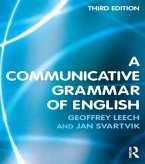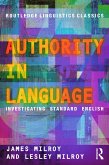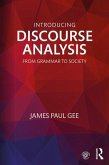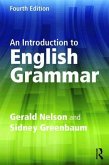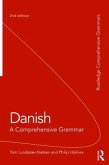American English Grammar introduces students to American English in detail, from parts of speech, phrases, and clauses to punctuation and explaining (and debunking) numerous "rules of correctness," integrating its discussion of Standard American grammar with thorough coverage of the past sixty years' worth of work on African American English and other ethnic and regional non-Standard varieties. The book's examples and exercises include 500 real-world sentences and longer texts, drawn from newspapers, film, song lyrics, and online media as well as from Mark Twain, Stephen King, academic texts, translations of the Bible, poetry, drama, children's literature, and transcribed conversation and TV and radio shows. Based on twenty years of classroom testing and revision, American English Grammar will serve as a classroom text or reference that teaches students how to think and talk not only about the mechanics of sentences but also about the deep and detailed soul and nuanceof the most widely used language in human history.
"Notwithstanding the abundance of grammar books, we have a critical need for a unique text on American English that treats diversity as natural and is based on sentences and texts representing a full range of uses-from well-known, expert writers to online media and song lyrics. This is such a text as it guides students to see the language soul beyond the structure of sentences."
-Walt Wolfram, North Carolina State University, USA
"I took Dr. Katz's grammar course while he was developing American English Grammar, and his training proved revolutionary for my teaching, my students, and my own personal understanding of grammar. Dr. Katz's common-sense approach to describing how language comes together, rather than the traditional defining of rules, has helped me give my students the freedom to explore language with joy and delight. Instead of requiring students to memorize lists and rules, AEG scaffolds the skills necessary to truly study the inner workings of our nuanced language."
-Erik Czerwin, English Language Arts teacher, Rockford, Illinois, USA
"I approach American English Grammar having had the benefit of learning from an earlier version of this textbook as an undergraduate. The foundation in analytical grammar that AEG provides equips the diligent student with the tools needed to understand not just what we write, but how and why we do so. The true strength of AEG is in its extensive examples and in how it encourages discussion and argumentation in classification. In my own educational career, while I was rarely called upon to diagram a sentence, I have often fallen back on the analytical training this text provides while in both the EFL and the college composition classroom."
-Christopher Douglas, Jacksonville State University, USA
"Many grammar textbooks relegate discussion of nonstandard varieties to a single chapter; however, American English Grammar discusses nonstandard variation in each chapter and provides examples of variation within each subcategory of discussion. This is important because students see variation in all areas of grammar, which means as they learn grammatical analysis they learn that different varieties demonstrate different features. The significant result is that variation is not error and that Standard English is not 'correct' English. A second key aspect of AEG for me is the use of examples that demonstrate the concepts being discussed, drawn from existing texts and almost always working with sources and language in use. That helps both students and instructors. ... I appreciate Katz's sense that the goal is to become an analyst, not to analyze in one particular way, encouraging students to think in terms of interpretation and evidence rather than correct and incorrect."
-John M. Ware, Wofford College, USA
"Seth R. Katz's American English Grammar is a college-level textbook that introduces the basic grammatical elements that define American English, not only those of Standard English (SE) but also several varieties of the language. Katz differentiates standard and non-standard varieties of American English Grammar (AEG) on the basis of differing rules rather than treating the standard as a measure of correctness. In so doing, Katz equips students to both understand the workings of SE and to critically analyze the social basis for its position as a standard. Indeed, through a descriptive approach to grammar education, this book has the potential to empower students to distinguish between varieties of English by their different rules. As a result, readers develop an understanding that discrimination is often based in an individual or social group's use of one set of grammatical rules over another. ... American English Grammar provides a thorough description of the most basic elements of AEG in a manner that engages with its student audience. The book covers eight grammatical elements: nouns, prepositions, adjectives, determiners, pronouns, verbs, adverbs, and conjunctions. Throughout, Katz provides examples from diverse texts, from ancient texts like the Bible to transcriptions of contemporary TV shows. Moreover, he demonstrates various approaches to interpreting particular passages; he makes clear where his exposition diverges from traditional and prescriptivist approaches to the study of grammar, and where applicable, he offers ways of testing a particular interpretation. At the end of each chapter, Katz provides exercises and a list of key points to recap the content covered, and he concludes the book with a review exercise where students are asked to analyze a brief essay from a popular magazine and identify all the grammatical structures covered in the book. ... Accessible and filled with tools, American English Grammar provides college-level students with the critical lenses to assess the rules which define the common varieties of AEG, including but not limited to SE. By explaining the grammatical rules that non-standard varieties follow, as well as the arbitrary history of many SE rules, this book empowers students with the descriptive tools to critically understand how the English language works and what makes one variety different from another. In short, this book gives students the tools and confidence to think like descriptive grammarians by making the study of English grammar inclusive of multiple varieties of AEG and of multiple interpretations of grammatical elements."
-The ATEG Journal 30 (2021)
-Walt Wolfram, North Carolina State University, USA
"I took Dr. Katz's grammar course while he was developing American English Grammar, and his training proved revolutionary for my teaching, my students, and my own personal understanding of grammar. Dr. Katz's common-sense approach to describing how language comes together, rather than the traditional defining of rules, has helped me give my students the freedom to explore language with joy and delight. Instead of requiring students to memorize lists and rules, AEG scaffolds the skills necessary to truly study the inner workings of our nuanced language."
-Erik Czerwin, English Language Arts teacher, Rockford, Illinois, USA
"I approach American English Grammar having had the benefit of learning from an earlier version of this textbook as an undergraduate. The foundation in analytical grammar that AEG provides equips the diligent student with the tools needed to understand not just what we write, but how and why we do so. The true strength of AEG is in its extensive examples and in how it encourages discussion and argumentation in classification. In my own educational career, while I was rarely called upon to diagram a sentence, I have often fallen back on the analytical training this text provides while in both the EFL and the college composition classroom."
-Christopher Douglas, Jacksonville State University, USA
"Many grammar textbooks relegate discussion of nonstandard varieties to a single chapter; however, American English Grammar discusses nonstandard variation in each chapter and provides examples of variation within each subcategory of discussion. This is important because students see variation in all areas of grammar, which means as they learn grammatical analysis they learn that different varieties demonstrate different features. The significant result is that variation is not error and that Standard English is not 'correct' English. A second key aspect of AEG for me is the use of examples that demonstrate the concepts being discussed, drawn from existing texts and almost always working with sources and language in use. That helps both students and instructors. ... I appreciate Katz's sense that the goal is to become an analyst, not to analyze in one particular way, encouraging students to think in terms of interpretation and evidence rather than correct and incorrect."
-John M. Ware, Wofford College, USA
"Seth R. Katz's American English Grammar is a college-level textbook that introduces the basic grammatical elements that define American English, not only those of Standard English (SE) but also several varieties of the language. Katz differentiates standard and non-standard varieties of American English Grammar (AEG) on the basis of differing rules rather than treating the standard as a measure of correctness. In so doing, Katz equips students to both understand the workings of SE and to critically analyze the social basis for its position as a standard. Indeed, through a descriptive approach to grammar education, this book has the potential to empower students to distinguish between varieties of English by their different rules. As a result, readers develop an understanding that discrimination is often based in an individual or social group's use of one set of grammatical rules over another. ... American English Grammar provides a thorough description of the most basic elements of AEG in a manner that engages with its student audience. The book covers eight grammatical elements: nouns, prepositions, adjectives, determiners, pronouns, verbs, adverbs, and conjunctions. Throughout, Katz provides examples from diverse texts, from ancient texts like the Bible to transcriptions of contemporary TV shows. Moreover, he demonstrates various approaches to interpreting particular passages; he makes clear where his exposition diverges from traditional and prescriptivist approaches to the study of grammar, and where applicable, he offers ways of testing a particular interpretation. At the end of each chapter, Katz provides exercises and a list of key points to recap the content covered, and he concludes the book with a review exercise where students are asked to analyze a brief essay from a popular magazine and identify all the grammatical structures covered in the book. ... Accessible and filled with tools, American English Grammar provides college-level students with the critical lenses to assess the rules which define the common varieties of AEG, including but not limited to SE. By explaining the grammatical rules that non-standard varieties follow, as well as the arbitrary history of many SE rules, this book empowers students with the descriptive tools to critically understand how the English language works and what makes one variety different from another. In short, this book gives students the tools and confidence to think like descriptive grammarians by making the study of English grammar inclusive of multiple varieties of AEG and of multiple interpretations of grammatical elements."
-The ATEG Journal 30 (2021)



